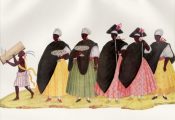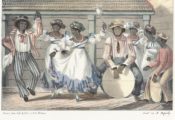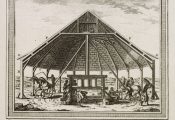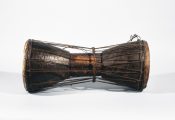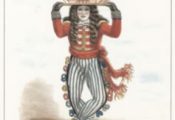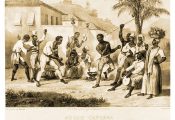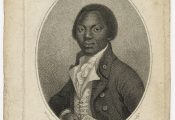The plantation model
The Spanish and Portuguese first began sugar cultivation on plantations on the Atlantic islands – the Canaries, Cape Verde and Madeira – then on São Tomé and Principe in the Gulf of Guinea. On those islands, close to the African coast, they also began to use African slaves, which were shipped a relatively short distance from the kingdom of Kongo. The sugar produced, shipped north to Europe, stimulated the European taste and demand for ever more sugar.
But the giant leap in the popularity of the plantation model occurred with the transfer of it to the Americas.
Columbus carried sugar cane on his second transatlantic voyage in 1493. Within a decade, it was being cultivated in Santo Domingo on Hispaniola (now Haiti and the Dominican Republic) by men trained in this form of agriculture in the Canaries. From there, the Spanish developed sugar plantations in Jamaica and Puerto Rico. But sugar plantations really took off in Brazil under the Portuguese and Dutch, the cane initially being transplanted from Madeira in the 1540s. Two decades later, Brazil was producing 2,500 tons of sugar a year.
The rise of the Brazilian sugar industry in the 16th century confirmed the importance of the plantation. Not surprisingly, it was copied by other European colonial powers when they settled their own tropical colonies in the Americas.
Portuguese and Dutch experience in Brazil, and Dutch finance for investment, helped others to turn to the lucrative business of sugar production. The first British settlements in the Caribbean (in St Kitts and Barbados) tried a range of crops before settling on sugar. After 1655, the new possession of Jamaica joined the list of British sugar producers, sugar again pushing aside other crops to become the island’s dominant cultivation.
The demand for slave labour
T he early plantations used a mix of labour: European settlers, local indigenous peoples and African slaves. This combination was rarely successful in sugar: Europeans disliked the work and the indigenous peoples refused to do it. Thus sugar soon came to depend overwhelmingly on forced African slave labour.
As sugar came to dominate the landscape, plantations became bigger. And as they proliferated and as demand for sugar in Europe increased, the plantations’ demand for Africans grew proportionally. Wherever a colony produced increased volumes of sugar, there we find massive importations of enslaved Africans. By 1600, perhaps 200,000 Africans had been shipped from West Africa as slaves. Fifty years later, that figure had increased to 800,000.
This was not true of sugar. In North America, the British turned to slavery for the cultivation of tobacco on plantations clustered around the Virginia, which provided an easy maritime route to Europe and, increasingly, to the centre of the tobacco trade in Glasgow. By 1750, some 145,000 enslaved Africans worked in the region. Later, when the British began rice cultivation in the Carolinas, they again turned to the plantation model and the number of slaves grew rapidly: by 1750, 40,000 had been trafficked there.
American cotton plantations
This massive expansion of the enslaved population of the Americas was all made possible, of course, by the transatlantic slave trade. In some regions, however, the enslaved population began to increase with the birth of children born on the plantations and planters came to rely less and less on arrivals from Africa. This was especially striking in North America.
The rise of cotton in the United States came late in the history of slavery. After 1800, plantations growing this crop began to spread across a huge stretch of the American South, as far west at the what is now New Mexico’s border. The plantation was once again the key to local commercial success. By 1860, there were 4 million slaves in the US, some 60% of whom worked in cotton.
But the plantation has a much broader importance than simply the history of sugar: it was the organisational tool that enabled European settlers to develop key areas of the tropical and semi-tropical Americas. And it did this primarily by providing colonial settlers with the crucial means of dragooning and organising unfree labour to raise a host of tropical and semi-tropical crops.
Different crops, different requirements
Wherever we look, slavery and plantations went hand in hand. The latter’s purpose was to extract the best return from both labour and land. But the varying requirements of crops meant that slave labour was organised differently depending on what was grown.
Working in sugar was especially harsh. Planters organised slaves around a gang system. The toughest work – planting, manuring, and cane-cutting – fell to the strongest and healthiest. Other, less physically demanding tasks were handled by gangs of less robust, younger or older slaves. Even the very young and the old were put to work: driving away birds, cleaning and guarding. From their early years until the onset of old age and infirmity, sugar slaves had to work. Sugar plantations also had factories that converted the harvested sugar cane into raw sugar and then into rum.
Tobacco plantations were smaller than sugar plantations. There, slaves did not work in gangs but often toiled side by side with free labour.
Salt ponds, like those found in Turk’s Island (now Turks and Caicos Islands) were particularly harsh. Workers would often suffer with boils from long hours of standing in the salt water. Mary Prince recalls,
‘This work was perfectly new to me. I was given a half barrel and a shovel, and had to stand up to my knees in salt water, from four o’clock in the morning til nine…. We were called again to our tasks, and worked through the heat of the day; the sun flaming upon our heads like fire, and raising salt blisters in those parts which were not completely covered. Our feet and legs, from standing in the salt water for so many hours, soon became full of dreadful boils… afflicting the sufferers with great torment.’
Rice plantations rivalled sugar for the arduousness of the work and the harshness of the working environment. But the forced workers engaged in rice cultivation were given tasks and could regulate their own pace of work better than slaves on sugar plantations.
Whatever the crop, labouring life was dictated by the cycles of the agricultural year. The sugar crop took six months to harvest. With tobacco, the process stretched over 18 months. Of course, the physical environment determined to a marked degree the unpleasantness of the enslaved’s working lives. On coffee plantations – located at higher, more temperate locations – work was not nearly as arduous as it was on sugar or rice plantations.
Levels of skill
Field hands tended to be labelled as unskilled, but their efforts were complemented by those of others. The plantations depended on skilled slaves – masons, joiners, coopers, metalworkers – to keep factories, fields, equipment and transport prepared and functioning. The needs of the wider slave community were served by other vital workers: cooks, nurses and seamstresses.
Those who were skilled and experienced in agriculture were often responsible for important decisions on plantations: when cane was ready to harvest, when sugar juices were ready, when tobacco leaves were ideal for picking, how best to pack, load and transport the commodities grown on the plantation.
Everywhere, in all plantation societies, domestic slaves catered for every need of local owners and managers, White and mixed-race, in their homes. Visitors to plantations were often amazed at just how many domestic slaves were to be found in and around the homes of planters and the managerial élite.
Slave labour in the wider world
Taking with them lessons learned on the plantation, the enslaved spilled out into wider colonial world. They were taken with their owners into nearby towns and ports, transporting finished produce to the dockside and collecting goods from the inbound Atlantic ships. Many were simply rented out as ‘jobbing’ slaves, to work at whatever task they were given by the men and women who paid their owners for their work.
The forced labourers worked in towns and on the quaysides, on local river boats and even on the Atlantic ships. They worked as cowboys in the frontier regions – and even found themselves employed as domestics to fashionable society in Europe. But all had come from the world of plantation slavery. Notably, the African parents of Dr Johnson’s servant Francis Barber had been plantation slaves in Jamaica.
The lash and other punishments
Plantation slaves were expected to work as and when their owners and ‘overseers’ dictated. To a marked degree, their treatment depended on the individuals in charge. Yet the most brutal aspect of their lives was not so much personal ill-treatment (though there was plenty of that), but the system itself.
Those who were forced to work on the plantations were considered chattel (items of property), commodities owned by others. Slave owners determined the nature of the enslaved’s daily working lives – and even what happened to them when they were not at work. The lash – both its image and its sound – is perhaps the most common memory of plantation slavery, and critics and visitors were often astonished at how frequently they saw plantation slaves physically abused. Normally such punishment was used to force them to work, but the lash was also employed for a range of offences or even in a cavalier fashion, in the hands of men and women to whom brutality was a way of life.
But plantation slavery did not function simply because of threats or violence. Slaves were also cajoled and persuaded to work. They were given small incentives – extra foods, clothing, time free from work – in the hope that they would work effectively. They were also given land on which to cultivate foodstuffs or rear animals for their own use. Yet violence was the ultimate threat and the lubricant of the entire system, much as it had been on the slave ship.
Personal violations
Plantation slaves suffered other personal violations. They could be moved from one property to another. An owner might, without notice, sell them to someone else, or they might be sold when a planter died or fell on hard times. Moreover, they might be moved simply because the owner had bequeathed them as part of his property to his children. Slaves found themselves removed, in an instant to a distant, unknown location, leaving behind family and loved ones, friends and community. This was one of the most bitterly resented features of plantation life right across all plantation colonies.
No less common and brutal was sexual exploitation. Slave women were always prey to the predatory sexual habits of their masters. Young and old, sisters, daughters and wives – all found themselves subject to sexual assault. The White men responsible for those assaults took little or no notice of the woman herself, her age, or her men folk, or family. Not surprisingly, it was a cause of deep hurt and humiliation. It was also often the cause and occasion for smouldering resentment or revenge if and when the opportunity arose – in whatever fashion seemed suitable.
Family and community
Although plantations were designed for work, they quickly became critical locations for the family and social life of enslaved people. Africans landed from the slave ships were overwhelmingly alone. Some arrived on a plantation in the company of ‘shipmates’ or with Africans from their native region in Africa, but they did not come there as families.
Yet within a very short time, the enslaved created new familial relationships. Partners settled into family units, rearing offspring in their own homes. However basic these homes might be, they became the focal point for raising new generations, born into slavery, who were taught the dangers and risks of life on a plantation and in the world at large. The slave family was the crucible from which slave culture developed. Whenever someone ran away it was often to someone (a relative, a lover) rather than away from their plantation. Relationships between individuals, with other members of the slave community and with White owners, all were explained and learned within the slave family.
The slave family was, of course, part of a broader slave community, which developed its own cultural patterns. Customs were derived not merely from the immediate plantation but from memories and survivals of Africa. Although cultures differed from one colony to another, they all shared certain features.
Religion
Africa inevitably dominated the way slaves behaved and what they believed. Their faiths and religions were derived from Africa, though often altered by life in the Americas. Some practices like, Voodoo, myalism, obeah and other practices emerged in this way. But the slave owners and colonial powers rarely accepted such beliefs as genuine religions.
Some enslaved Africans brought with them beliefs not unlike that of Christianity as noted by Equiano, ‘As to religion, the natives believe that there is one Creator of all things, and that he lives in the sun, and is girded round with a belt, that he may never eat or drink…. They believe he governs events, especially deaths or captivity….”
He later notes, ‘We practiced circumcision like the Jews, and made offerings and feats on that occasion in the same manner as they did. Like them also, our children were named from some event, some circumstance, or fancied foreboding at the time of their birth.…’
These ideals are interesting to note compared with the slavers views of Christianity or with Islam (notably 19th-century Brazil, there were strong Islamic elements in local slave life).
The faith of the enslaved – and their own preachers, rituals and ceremonies – provided a framework to help them deal with the present world (of plantation slavery) and prepare for the next. In addition, slave religions had a secular and temporal role: devotions and prayers – for better health, for security, for wishing others good or harm – all emerged from their’ own belief systems.
Moreover, these beliefs gave them strength in the hostile world of plantation slavery, offering them a world that was safe from, and secure against, the power and intrusion of slave owners (who did their best to outlaw and prevent such practices). Just as the enslaved valued their own beliefs, so were those beliefs distrusted and feared by owners and colonial powers right across the Americas.
For very similar reasons, slave owners initially disliked and obstructed the introduction of European Christianity among the enslaved on the plantation. When it took root, the enslaved naturally imposed their own style and gloss. Once it began to flourish, it became a powerful tool in the enslaved’s armoury.
This new Christianity provided a text (the Bible), and gave enslaved preachers the opportunity to emerge. It was practised in local slave congregations and was often expressed through communal singing. Here was an expression of the slaves’ secular and spiritual aspirations. Slave religion – African-based or transplanted Christianity – became a powerful means of organisation, communal expression and personal hope. And for all those reasons (and more), slave owners tended to dislike it.
Resistance
Many planters regarded slave religion as a form of resistance: a vehicle through which slaves could defy their masters’ wishes. Towards the end of slavery in the Americas the enslaved used religious meetings and their own encoded songs to provide secret messages of how to run away via the Underground Railroad. It would take many years after Emancipation for those codes to be shared and understood by the world.
In fact, slaves devised myriad ways of resisting. The most open – and most dangerous – was revolt. More common was the daily round of opposition that characterised plantation slavery everywhere: foot-dragging, feigning ignorance, being uncooperative and ‘artful’. When we add together these various slave responses, a picture emerges of persistent non-compliance, revealing that resistance was built into the social and human fabric of plantation life.
Yet the enslaved trod a delicate line and knew that too overt a reluctance, too bold a resistance, would merely provoke an angry punishment for themselves, their relatives or community. Those on the plantation learned how far they could go and knew that, if they overstepped the accepted bounds, they would face inevitable punishment, the ultimate of which was, of course, violence in one of its various forms.
On plantations as on the slave ships, violence was the lubricant liberally doled out by planters and their managers to secure the obedience and the labour of their enslaved labour force.
You can find artefacts in the theme of Plantation Conditions.
